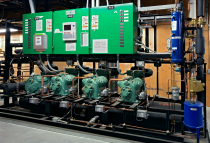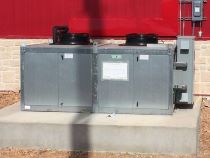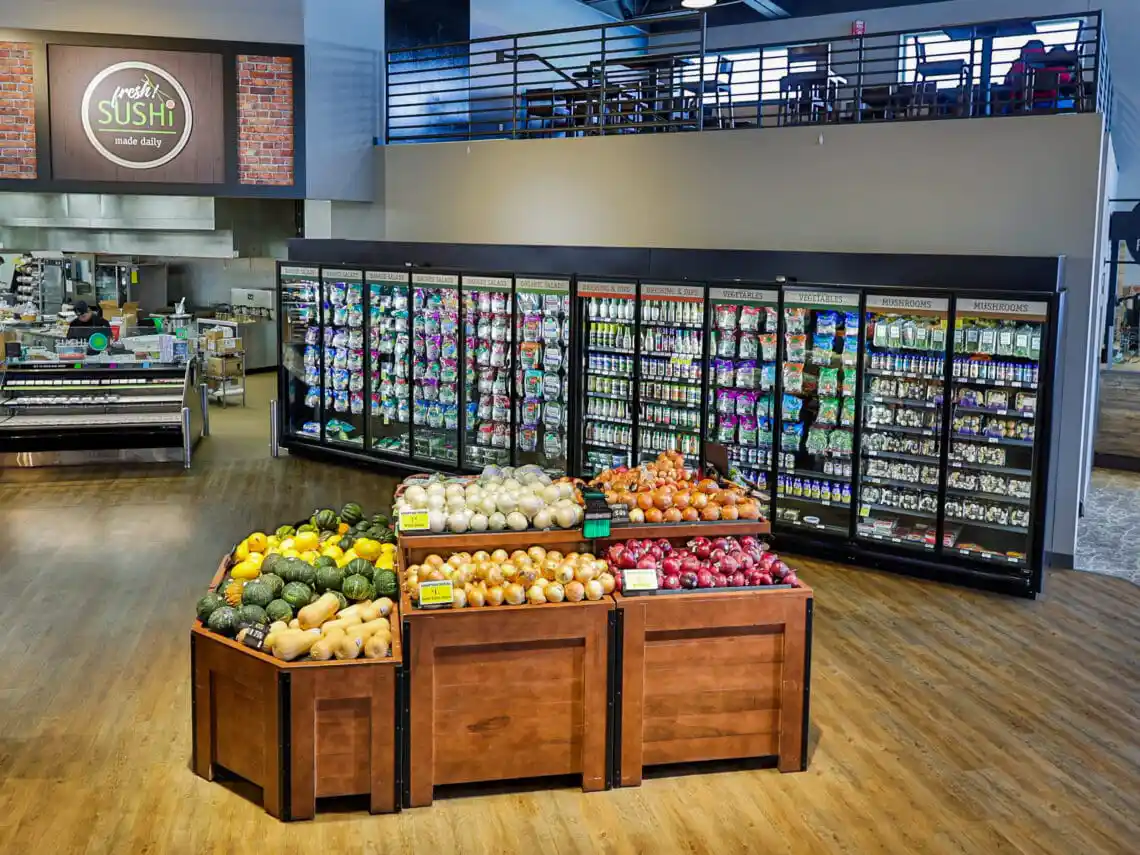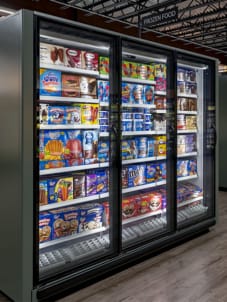A walk-in cooler turns into an oasis during the summer months. While this may bring you relief, it adds stress to your commercial or industrial refrigeration system. The efficiency of any refrigeration system drops as the ambient temperature increases. Pressure within the system also increases, putting strain on the entire system. For areas with warmer climates, this happens for a longer period of time during the year. There are many ways to mitigate stress and heat in your system, but which one works best for your application?
The Highlight Merchandiser® is a durable display case with classic charm. This workhorse offers a generous packout and a spectacular, full view of your product. Whether it’s protecting your frozen food, ice cream, beverage, dairy, deli, meat, ice, or produce, the Highlight Merchandiser® is up to the task.
Zero Zone reliability has built a trust with customers across North America. This trust grew from our small town in Wisconsin by selling to local retailers, such as Webster’s Marketplace. When Webster’s Marketplace expands, they choose Zero Zone for their display cases. DuWayne Wichman, one of the store directors, has said in an interview, “I can’t say enough good things about [Zero Zone display cases].” Inside Webster’s Marketplace, you’ll find Zero Zone display cases in operation from 1984, 2005, 2015, 2017, and 2024.
The Reveal Merchandiser® matches the diversity of your product with a variety of features. It has options for beverages, dairy, deli, meat, and produce. The multitude of lighting, shelf, and accessory options put you in control of creative merchandising. Read on to learn more about how you can “deck” out a Zero Zone Reveal Merchandiser®.
The Lineup
Before we can accessorize a display case, we have to know what we are working with. Zero Zone has four models for the Reveal Merchandiser® display case.
What is the difference between retail and industrial refrigeration? For starters, they are at different stages in the Cold Chain, a temperature-controlled supply chain of perishable goods. This supply chain starts with storage, processing, or both. Then it moves to transportation, then arrives at the final step, distribution. Retail refrigeration exists within the distribution step; think of places that need refrigeration and have a checkout counter. Industrial refrigeration exists before refrigeration at the retail level. Before we venture into the specifics of industrial refrigeration, let’s look at some common applications where Zero Zone systems have been used.
The Zero Zone Crystal Merchandiser® is more than a display case to keep your products cold, it is used to show off your product’s best features. The Crystal Merchandiser® is best used for floral displays, produce, dairy, deli, wine, beverages, ice cream, and frozen foods. The versatility of the Crystal Merchandiser® does not end with what can be displayed, but how its contents can be displayed.
What is a Small Format Store?
Small-format stores are usually less than 25,000 ft2 and require less than 30 tons of refrigeration capacity. Typically, these stores are convenience stores, small grocery stores, and pharmacies. Due to their size, Small-format stores do not have the space or lease agreement to install the large rack units that are favored by Large-format retailers. Another complication is how the small-format store needs to be organized for the display cases to fit.
Why CO2?
- Carbon dioxide (CO2) as refrigerant:
- Significantly reduces the environmental impact and plays a crucial role in combating climate change
- Is the gold standard for ozone depletion potential (ODP) at 0
- Has a global warming potential (GWP) at 1.
Many countries including the US are phasing out the use of high-GWP synthetic refrigerants, and stricter environmental regulations are being enforced. Embracing CO2 makes this a future-proof solution as it ensures compliance with these evolving regulations, avoiding penalties and legal complications.
CO2 is nonflammable and nontoxic, and it is a low-cost refrigerant. The recent advent of high-pressure, iron-impregnated copper has allowed the traditionally stainless-steel piping to transition to familiar brazed copper piping, further improving value and simplifying repairs.
Is CO2 Right for your Small Format Store?
CO2 is also a low-cost refrigerant. Most synthetic refrigerants can cost upwards of $20 per lb, whereas the current price of CO2 is around $3 per lb. CO2 systems require smaller copper pipes than other refrigeration systems, which decreases the installation costs. CO2 systems also have excellent energy efficiency, minimizing the operation cost. It’s high density and low viscosity increase coil efficiency, allow for smaller line sizes, and take advantage of smaller compressors.
Although everyone with a CO2 system can enjoy its benefits, small-format stores can go a step further. Since small-format refrigeration systems require less refrigerant, they do not require heat removal through air conditioning. This means the heat reclaim can be used for space heating, dehumidification, commercial kitchens, and restrooms.
Zero Zone knows that one size does not fit all. Our Genesys™ Natural Refrigeration Systems can be tailored for small format stores with the following products.

Indoor Parallel Systems

Outdoor Parallel Systems

Distributed Refrigeration Systems
Here are some case studies of using Zero Zone’s CO2 Genesys™ Natural Refrigeration Systems in small format stores:
- Small grocery store in Stapleton, CO
- Zero Zone completed this project using an indoor parallel system that can operate on a mezzanine in a mechanical room in a 5B climate zone. It has a remote adiabatic gas cooler, negating the need for air conditioning. The design pressure is 120 bar on the high side and 45 bar on the low side.

- Small format store in Islandia, NY
- This store is located in a 4A climate zone and home to one of Zero Zone’s outdoor parallel roof-mounted rack systems. This system has a remote air-cooled gas cooler and a design pressure of 120 bar high side and 90 bar low side.

- Convenience Store in Dayton, MN
- Zero Zone also has an outdoor parallel system mounted on the roof in a 6A climate zone. This system measures 120 bar on its high side and 45 bar on its low side. This location also uses the heat reclaim for heating the backroom air coil and water.

A common myth surrounding CO2 as a refrigerant is that it can only be used in certain climates. This is true only for certain types of CO2 systems. Transcritical CO2 systems can only be used in cooler climate zones. Subcritical CO2 systems can be used in any climate zone. At Zero Zone, we have a solution for natural refrigerants in any climate.
Are You Ready for Zero Zone’s Genesys™ CO2 System?
To start a project or learn more about how Zero Zone can help, contact one of our sales representatives.
What is the AIM Act?
The American Innovation and Manufacturing Act (AIM Act) was passed in 2020 by bipartisan support in the U.S Congress as the United States joined the global movement to reduce human impact on climate change. The AIM Act directs the U.S. Environmental Protection Agency (EPA) to oversee the phasedown of HFC refrigerant production and consumption in an effort to transition to alternative refrigerants. The AIM Act includes a phasedown schedule that began in 2022 and continues to 2036.
The new rule prohibits the manufacture and import of self-contained products that use hydrofluorocarbons (HFCs). The rule also prohibits the sale, distribution, and export of products three years after the manufacture and import restriction. Finally, it prohibits the installation of new refrigeration air conditioning and heat pump (RACHP) systems that contain HFCs. The compliance dates of these new rules vary based on sector and subsector.
Who does the AIM Act refer to?
The final rule states, “Entities that manufacture, import, export, sell, distribute, or install systems or products that use HFCs in refrigerants and air-conditioning equipment systems, heat pumps, foams, and aerosols may be affected by this new rule. Restrictions apply to original equipment manufacturers, product distributors, retailers, and companies that direct the installation of new RACHP systems.”
Important definitions
The final rule makes a distinction between products and systems. Certain products and the installation of certain systems have different restrictions.
A product is functional upon leaving a factory. Examples of products include self-contained refrigerators and self-contained ice machines. The EPA is restricting the sale, distribution and export of products containing higher-GWP HFCs three years after the manufacture and import restriction dates.
A system is assembled and charged in the field using multiple components. An example of a system is a supermarket refrigeration system that include a centralized compressor room. Components include equipment such as compressors, condensers, and display cabinets. There is not a restriction on the manufacture, import, sale, distribution, or export of components that are used to repair existing systems.
When will the phasedown start?
Self-Contained Configuration

Remote Configuration

 Notes:
Notes:
- Industrial Process Refrigeration (IPR) systems are used to cool process streams at a specific location in manufacturing and other industrial processes (e.g., chemical, pharmaceutical, petrochemical, and manufacturing industries).
- Refers to the Zero Zone Hybrid™ display cases and rack condensing units (Edge XT).
- Refers to Zero Zone’s Highlight®, Crystal®, and Reveal® display cases and their associated systems.
Why was the AIM Act proposed and passed?
The AIM Act addresses petitions from industry, environmental organizations, and state governments to restrict the use of HFCs. The EPA has estimated the potential benefits of this rule will provide savings to American consumers and industry through energy efficiency and lower-cost refrigerants. The EPA stated that this rule will also result in greenhouse gas emissions reduction benefits.
- EPA estimations:
- Emission reduction of 876 million metric tons of carbon dioxide equivalent through 2050.
- $50.4 billion in climate change mitigation benefits
- $4.5 billion in cost savings to consumers and businesses driven by the lower cost of HFC substitutes and increased energy efficiency of lower-GWP refrigerants
For our customers
This rule does not restrict Zero Zone customers from using their existing refrigeration systems. The EPA has allowed an existing system to continue its operation to the end of its useful life. The systems may be serviced and repaired throughout their use, including replacing components. Components needed for repair are allowed to continue being manufactured.
For new installations, the equipment needs to be charged before the compliance dates. The following actions are considered a new installation:
- Assembling a system for the first time from used or new components;
- Increasing the cooling capacity, in BTU per hour, of an existing system; or
- Replacing 75 percent or more of evaporators (by number) and 100 percent of the compressor racks, condensers, and connected evaporator loads of an existing system.
Into the Future: Refrigerant Management
Although a system can be serviced until the end of its useful life, the refrigerants used to recharge it will become scarce as production slows. The costs of synthetic refrigerants are expected to rise. The EPA is currently working on a standard for refrigerant reclamation and requirements for reclaimed HFC refrigerants. They are proposing that as of January 1, 2028, reclaimed refrigerant must be used when servicing and/or repairing refrigerant-containing equipment. This includes supermarket systems and stand-alone retail food refrigeration.
If you have questions about these regulations, please contact Zero Zone and ask to speak to our Director of Regulatory Compliance & Refrigeration Technology, Bruce Hierlmeier.
How can Zero Zone Help?
At Zero Zone, we’ve always been green. Zero Zone offers sustainable refrigeration solutions with Genesys™ Natural Refrigeration Solutions. If you want to learn about our offerings and plans for these new regulations, contact our sales team or visit Zero Zone’s Genesys™ Natural Refrigeration Solutions webpage.
View the infographics for our Retail and Industrial customers for a summary of important facts and dates.
Load Requirements & Challenges
Private label juice manufacturer Citrus Systems, Inc. specializes in pasteurizing an extensive line of juices and fruit drinks. The business provides juice to local dairies, grocery stores, and institutional customers. Their success and future contracts led them to build a new facility that was twice as large as their previous location. This presented some challenges for their refrigeration needs.
- Large capacity needed
- 2 pasteurizers
- 6 packaging lines
- 18 blending and storage vessels
- 560,000+ cubic feet of storage
- Doubled square footage from previous facility
- Previous system was assembled on-site instead of a packaged unit
- Must follow precise HACCP food safety guidelines from FDA
The Zero Zone Solution
- Provided three refrigeration systems to meet capacity:
- Low temperature rack: 82 tons of cooling at -23°F
- Medium temperature rack: 124 tons of cooling at +20°F
- 4-Circuit chiller: 240 tons of cooling at +18°F
- Designed and built a package rack system to be installed on-site
- To ensure food safety, system includes remote monitoring and diagnostics
The refrigeration systems were designed to provide trouble-free, energy-efficient operation for their production process. Zero Zone included features and technology to match the needs of pasteurization plants, such as multiple chilling circuits, industrial PLC controls, and evaporative condensing with variable speed fan control. A heat reclaim system off the compressor discharge circuit reduces both electric and natural gas demand by repurposing heat for hot water used throughout the production facility.
Being able to guarantee that the system always maintains temperature is essential for their HACCP program. To monitor operation and communicate any alarm conditions, Citrus Systems needed a remote diagnostics system connected to the refrigeration equipment. Consistency and dependability are essential in the pasteurization and food processing industries to protect the quality of the final product.
A Satisfied Customer
Thomas E. Boehland, founder and president of Citrus Systems, takes great satisfaction in how everything came together, describing the equipment as “a work of art.” He praised the Zero Zone team: “You can tell that there is a lot of pride in what they put together. It isn’t just a bunch of refrigeration components that are cobbled together on-site to get the job done. It’s a nice package and you can tell just looking at it. The factory people take pride in it and even sign off on the equipment with each individual person putting their names to it. You don’t see that very often these days.” Boehland concluded by saying, “I’ve put my faith in Zero Zone to do what we need to be done.”
Contact our sales team to get started on your next refrigeration journey.
Read more in the full case study: “An Industrial Work of Art.”
At Zero Zone, the gold standard is a crystal: a Crystal Merchandiser®. These reach-in display cases have served retailers across every application: beverage, dairy, deli, meat, produce, and frozen food. To understand why, let’s look at 5 reasons that retailers love the Crystal Merchandiser®.
#1: Excellent Energy Efficiency
Up to 84% less energy than open multi-decks
Up to 45% less energy than other reach-in coolers
We know what matters most of all, and that is profit and cost. The Crystal Merchandiser® is the clear choice for maximizing profit while minimizing operating cost. These cases were engineered for excellent energy efficiency, especially against open multi-deck cases (up to 84% less energy) and even against other reach-in coolers (up to 45% less energy).
A retailer’s vice president of facilities and equipment said, “The energy savings are what really make you stop and say, ‘I need to take a serious look at this’. Then you start getting into things that become more apparent once you have the cases in—the comfort in the aisle, how great the product labels appear from the LED lighting—all of those subsequent advantages.”
#2: 74″ Tall CoolView® Doors
Not only do Zero Zone cases have excellent energy efficiency, but they are energy efficient while also having some of the largest doors in the industry. These 74″ tall doors open up the Crystal Merchandiser® to shoppers, making it easy for them to see products and make their selection.
Our 30″ wide CoolView® Illusion® doors for our low-temperature cases are known for glass that goes all the way to the edge of the door, giving the impression that the case is open even when the door is closed. The effect is most dramatic for a lineup of cases where the aisle will look like a wall of enticing product. Shoppers may be under the illusion that the door is not even there.
Crystal Merchandiser® Low Temp RVLC30 with CoolView® Illusion® Doors
The medium-temperature cases use CoolView® Ultra™ doors, which are notable for their broad display and slender frames. These are available as either 24″ wide French-swing doors or as 30″ wide single-swing doors. This lets retailers pick the right door to fit their merchandising strategy and store planogram.
#3: More Facings & More Packout
With taller doors comes increased product facings: up to 35% more facings than other display cases. In addition, the Crystal Merchandiser® also offers more merchandising space with 6 full shelves, which means up to 25% more packout. “We are able to get an entire case of 6-packs out as well as 3 12-packs on each shelf,” a liquor store manager noted. “You might think that with 6 shelves instead of 5, it might be more difficult for the consumer to pull product off of the shelving, but it has actually been easier.”
For even more space, take a look at the Zero Zone Deep cases, which allows you to fit 4 30-packs of 12 oz. cans in the bottom basket.
Crystal Merchandiser® Medium Temp RVMC30D Deep Case
Extra space can be valuable in any department in a store. Another store manager said, “In the yogurt section, with the old open cases that weren’t self-feeding, you would have to restock after you sold 6 units—or pull it all forward. But in this situation, you fill it once, you go back in mid-day and refill it. I mean, the labor savings is astronomical—about an hour and a half a day. That’s one of the ways we’ve been able to cut some inefficiencies.”
#4: More Efficient Use of Floor Space
Part of the genius of the Crystal Merchandiser® is that in addition to offering more facings and packout, the case actually uses less floor space within stores. The Crystal Merchandiser® is only 39 1/2″ from the back of the case to the front of the door handle. It is up to 7″ narrower than multi-deck cases. This allows retailers to use that space elsewhere or to simply have wider aisles, which shoppers appreciate.
#5: Reduced Shrink & Increased Shelf Life
The Crystal Merchandiser® also helps stores by reducing product shrink and increasing shelf life, which is especially pertinent to meat departments and produce departments.
In the words of a meat department manager, “Are the products holding up better? Absolutely! There’s no question it’s enhanced the shelf-life of the products.” The manager also reported that the meat held its vibrant, fresh color longer. A meat cutter told us, “It actually preserves the meat longer, gives it more life. It’s better for the customer; they get a fresher product. It’s better for us, as a company; we save more money, and we sell more, too.”
This benefit carries over to the produce department. Anything you put in the Crystal Merchandiser® stays fresh and beautiful longer. Spoilage is down, and shoppers take home produce that is fresher. As a produce department manager told us, “Since we began using the Crystal Merchandiser®, our shrink on bagged salad and cut fruit has been reduced by as much as 50%. The consistent temperature is the key.”
Are You Ready?
Have you fallen in love with the Crystal Merchandiser® too? Now is the time to contact the Zero Zone sales team to choose the Crystal Merchandiser® for your next store.

 Notes:
Notes:










